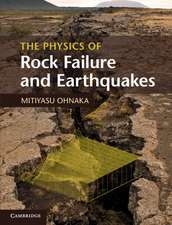Source Mechanisms of Earthquakes: Theory and Practice
Autor Agustín Udías, Raúl Madariaga, Elisa Bufornen Limba Engleză Hardback – 23 apr 2014
Preț: 554.56 lei
Preț vechi: 623.10 lei
-11% Nou
Puncte Express: 832
Preț estimativ în valută:
106.11€ • 110.80$ • 87.63£
106.11€ • 110.80$ • 87.63£
Carte tipărită la comandă
Livrare economică 16-30 aprilie
Preluare comenzi: 021 569.72.76
Specificații
ISBN-13: 9781107040274
ISBN-10: 1107040272
Pagini: 311
Ilustrații: 154 b/w illus. 10 tables
Dimensiuni: 193 x 253 x 18 mm
Greutate: 0.82 kg
Editura: Cambridge University Press
Colecția Cambridge University Press
Locul publicării:New York, United States
ISBN-10: 1107040272
Pagini: 311
Ilustrații: 154 b/w illus. 10 tables
Dimensiuni: 193 x 253 x 18 mm
Greutate: 0.82 kg
Editura: Cambridge University Press
Colecția Cambridge University Press
Locul publicării:New York, United States
Cuprins
Preface; 1. Earthquakes and fault motion; 2. Processing and analysis of recorded seismic signals; 3. Mathematical representation of the source; 4. Point source models; 5. The seismic moment tensor; 6. Determination of point sources; 7. Kinematic extended sources; 8. Determination of source dimensions; 9. Simple dynamic models; 10. Dynamics of fractures. Homogeneous models; 11. Dynamics of fractures. Heterogeneous models; 12. Determination of dynamic parameters; References; Index.
Recenzii
'An excellent and timely book - the first textbook to provide such a detailed and complete overview on the theory of earthquake source mechanisms, and to combine the classical continuum mechanics approach with concepts of kinematic and dynamic rupture models. This book will become an essential reference and valuable resource for researchers, professionals and graduate students.' Professor Dr Torsten Dahm, Helmholtz Centre Potsdam, GFZ German Research Centre for Geosciences
'This is an up-to-date, comprehensive, quantitative treatment of an important topic in seismology. It is unique in that theory and data analysis are both discussed in-depth, and it covers fundamental ideas from the 1960s to the very latest developments, making it the essential text for graduate students and researchers. Along with its very complete bibliography, it will become the Bible of the subject.' Professor Shamita Das, University of Oxford
'This is an up-to-date, comprehensive, quantitative treatment of an important topic in seismology. It is unique in that theory and data analysis are both discussed in-depth, and it covers fundamental ideas from the 1960s to the very latest developments, making it the essential text for graduate students and researchers. Along with its very complete bibliography, it will become the Bible of the subject.' Professor Shamita Das, University of Oxford
Notă biografică
Descriere
An innovative new approach to studying earthquake source mechanisms, combining theory and observation, for graduate students, researchers and seismology professionals.









